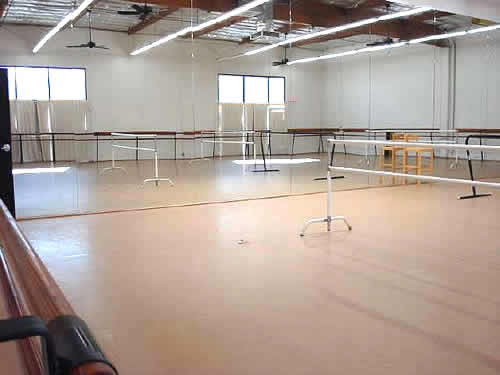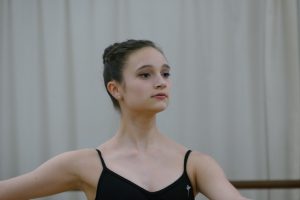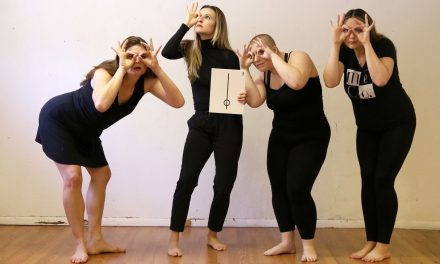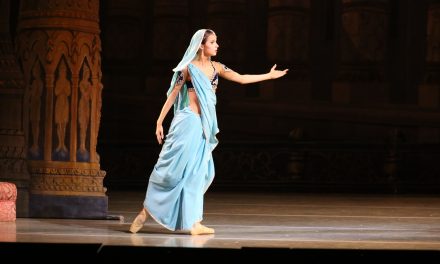On April 7, 2018, the Maple Youth Ballet will present two performances of Cinderella, choreographed by Artistic Director Charles Maple, at the Barclay Theatre in Irvine. I visited the Maple Conservatory of Dance to watch a rehearsal of Cinderella and to interview Mr. Maple. I was encouraged to see such professional instruction being taught to these young dancers and to meet the dedicated all-volunteer staff that creates the production’s costumes, sets, props and who assist in directing the students during rehearsals and performances.
Based in Irvine, CA., the Maple Conservatory of Dance was founded in 2007 by Charles Maple and Kathy Crade, the Ballet’s Executive Director. The conservatory includes three large studios, a smaller one and a sizable studio that also functions as a prop/costume storage and conditioning room. There are dressing rooms, costume construction and work rooms, and administrative offices. The studios have beautifully sprung floors, built-in and portable ballet barres and many smiling students taking class, rehearsing or seated in the central waiting room to take class. Some were busily tending to their school work. The training is highly professional and the dancing in the rehearsal I attended, was stellar for young dancers of this age. The conservatory offers this excellent training in their studios for ages 2 to adult.
One of the first things that Charles Maple stressed to me was that what they have at the conservatory is a family-like enterprise. “We are not a professional organization in terms of hiring out things“ he said. “We are professional in what we produce.” I met Alec Haskell, the Props and Backstage Manager, as well as some of the production crew; all busy moving set pieces and props into the studio for rehearsal. Haskell said that there were approximately 15 people working the show and reiterated that everyone volunteered their time. Haskell is actually a Professor of American History. The volunteers construct, paint and, when needed, refurbish the sets and props, as well as work backstage during performances.
Charles Maple emphasized that the crew takes great pleasure in seeing their work onstage and that they have a lot of input into how things can be reworked or improved. Everyone was intently involved, enthusiastic and appeared to take a humbled pride in their contributions to the students’ lives and futures. The same was true with the volunteers in the costume shop; all busily sewing. Kattya Scott, the Costume Designer, explained what everyone’s duties were. I met Steven Inskeep whose title is Tiara and Accessory Designer. The jobs of beading, sewing, etc. are divided among the volunteers, many of whom have children studying at the conservatory. Here too, the work produced by these volunteers is of excellent quality and quite beautiful.
Former dancer, Barbra Abell, is the head Costume Mistress and mother to one of the dancers performing in Cinderella. She confessed that she does not sew at all but organizes the costume shop, deciding where things are stored, taking inventory, scheduling costume fittings, and she oversees getting the costumes cleaned and packed away between productions. Abell is also a Pilates instructor at the conservatory.
Charles Maple began studying ballet to strengthen his knees after injuring them playing football. He had previously studied tap and drama in La Puente, CA. with a teacher who saw his talent and directed Maple to a more serious ballet studio in Pasadena. There, under the direction of Irina Moskosoff, he auditioned for and received a scholarship from the Ford Foundation. Maple moved to New York to study at the School of American Ballet (SAB) which was founded in 1934 by George Balanchine and Lincoln Kirstein. In 1948, these two giants of the dance world then founded the New York City Ballet. After six months, a lead dancer in one of Balanchine’s ballets was injured, and Maple was chosen to replace him. Lucia Chase, the Ballet Director and co-founder of American Ballet Theatre (ABT) happened to be in the audience the night that Maple performed, and she was very impressed by his performance. Ms. Chase called him the next morning and offered Maple a position in the Corps de Ballet. Inspired by the roles of the male dancers at ABT, he chose to accept Chase’s offer, and over time earned the title of soloist.
Maple later auditioned for the San Francisco Ballet, but was offered a job as Principle Danseur with the Basel Ballet based in the 14th Century town of Basel, Switzerland. At the time the company was under the direction of the very prolific choreographer, Heinz Spörli. Maple moved to Europe to work at The Ballettschule Theater Basel which included two touring companies and its own theater. Maple said that the organization paid its dancers a year-round salary along with a year-end bonus check.
“Plus,” Maple added. “because we were city employees, if the sanitation workers got a raise, we got a raise. It was very easy to be an artist there.” He stayed with the Basel Ballet for ten years before moving back to the United States. Inspired by Heinz Spörli’s work, Maple decided to try his hand at choreography and creating his own versions of classical ballets like Cinderella.
Maple and his ex-wife Gilma Bustillo moved back to Pasadena because his mother had become ill. There, he became Director of the Pasadena Dance Theatre for several years and then set about freelancing as a teacher and choreographer throughout Southern California. The building where the conservatory is located was then owned and run by Molly Lynch and Gillian Finley. Lynch was the Artistic Director for Ballet Pacifica from 1988-2003 and after she left, the studio had a series of artists and directors who were unable to keep the business afloat.
Maple had long dreamed of owning his own organization where he could choreograph and teach in the style of his choice, but it was his current partner in life, Kathy Crade, who suggested that they take over the Irvine building’s lease and open a ballet school. When they moved the building had been completely emptied. They did have the essentials of studio floors, mirrors and build-in ballet barres, but there were no pianos or computers and only approximately 20 students. They bought costumes and other items from the Golden State Dance Company that was closing its doors and, “taking a deep breath“, opened the Maple Conservatory of Dance in 2007. Maple explained that the conservatory is their business and the Maple Youth Ballet is under their non-profit.
They have come a long way since they first opened their doors, and every studio was filled with students. “This is our tenth Anniversary,” Maple said. “and now we need more room!”
The conservatory offers professional training by teachers who have had professional dance careers. The two that I met were Patrick Franz and Kristin Hakala. Franz was a Premier Danseur with the Paris Opera Ballet, and Principal Dancer and Resident Choreographer with the Pennsylvania Ballet. He was the Artistic Director of Pittsburgh Ballet Theatre where he also founded the Pittsburgh Ballet Theatre School. Hakala first performed with the Nashville Ballet and most recently, she was a principal dancer with Ballet West in Salt Lake City, Utah. The training at the conservatory is based on the ABT curriculum; a technique that Maple described as a fusion of several classical techniques, “All of whom claim to be the one true method of teaching.” He said. “ABT took the best of all these methods.”
As Maple expressed it, “Our goal is to give the dancers a professional level experience. That is what we try to do. From the costumes, the props, the way we stage things, the choreography and from the training itself, what they get is a professional experience.” He said that there are, of course, students who take class simply for recreation, but stressed that they work alongside students whose aspirations are to become professional dancers.
Many former students of the Maple Conservatory of Dance have gone on to join professional companies that include Alabama Ballet, Charlotte Ballet, California Ballet, San Francisco Ballet, New York City Ballet, Oregon Ballet, Pennsylvania Ballet, American Ballet Theatre, Royal New Zealand Ballet and the Los Angeles Ballet.
In lieu of taking part in ballet competitions, the conservatory joined an organization of like ballet companies called Regional Dance American (RDA). RDA’s goal is to maintain the highest standards of ballet training among its members and each school is evaluated every year by an RDA appointed adjudicator. Maple explained that the adjudicator did not simply observe classes, but that they are required to present two ballet works, show their publicity materials, and demonstrate the quality of their community outreach. They must prove that their classes remain at a certain level and that the dancers demonstrate proper class etiquette. Maple often presents one of his ballets and one or two works choreographed by students. It is a chance for these young choreographers to present their work and to have it professionally adjudicated.
If a school twice fails to meet the high standards set by the RDA, it is dropped. So, everyone at the conservatory must be well prepared. “It kind of sets a fire under our butts.” Maple mused. Following the performances of Cinderella in April, the Maple Youth Ballet will attend the RDA sponsored festival in Spokane, Washington. There the dancers will perform, take classes and have the opportunity to see ballets performed by students from comparable companies within their region.
In Fredrick Ashton’s version of Cinderella, the two step-sisters are performed by men. In Maple’s version they are girls. “I have an entirely different concept of the ballet.” He said. “I took the concept that the Spirit Mother is actually her (Cinderella’s) mother.” In his version, the Spirit Mother appears in different forms, such as an old woman who comes to Cinderella’s house selling goods. It is only Cinderella, however, who can see her. “Cinderella is such a loving person and a generous person.” Maple added. “I see the Spirit Mother as someone who is overseeing her journey, protecting Cinderella through all the awful things that befall her.”
Maple wanted to have both Cinderella and the Prince be very young. “I wanted the love that they experience to be genuine, very immature and very puppy like. And, through that puppy like love, there is something very human, very emotional and very endearing to the audience.” He explained.
Maple’s Cinderella is in two acts instead of three as in most professional versions of the ballet. The ballet opens with Cinderella planting a tree at her mother’s grave and as the ballet progresses, the tree grows larger and larger to finally create an entire canopy over the stage. It is a wonderful image of a mother’s love protecting her child.
Most of the cast for Cinderella are students of the conservatory, but there are two, at least, who Maple brought in from the outside. Erik Kim, who will be performing the role of the Prince, is 17 years old and currently enrolled at the North Carolina School of the Arts in Winston-Salem. Another young man, Jack Pattillo, is a student at UC, Irvine and he will dance the roles of the step-sisters’ Ballet Master and one of the Prince’s friends.
I spoke briefly to Erik Kim before he went into rehearsal. He was born in Little Rock, Arkansas but now lives in North Carolina. Offered a scholarship with the San Francisco Ballet, Erik instead chose to attend the North Carolina School of the Arts where he studies ballet with, among others, Russian born Ilya Kozadayev .
Charles Maple said that Erik quickly became endeared by the other students at the conservatory, and Erik told me that he feels very supported by everyone. Maple asked him how he felt about working with his Cinderella, 16 year old Erin Blair. “She’s great.” Erik said. “She is very sweet and a very good dancer.” While speaking to how he approaches the role of the Prince, Erik explain that upon seeing Cinderella for the first time in the ballet’s ball scene, how he tries to portray everyone else disappearing. “When I am dancing with Cinderella, I’m not looking at anyone else. She has taken my heart.”
It was time for rehearsal, so we moved into Studio 1 where the stage crew was completing the task of setting up Act I of Cinderella. The studio was abuzz with dancers warming up and parents directing the youngest dancers into their positions off stage. The atmosphere was very professional, and I was impressed at how disciplined all the dancers were and how happy they all appeared. The cast of Cinderella was directed with a firm but loving hand by Ballet Master, Steven Inskeep, who used each dancer’s first name when calling out instructions and corrections. It was clear that everyone in the cast, the youngest only 6 years old, knew to keep dancing while adhering to Inskeep’s commands.
Erin Blair is indeed a lovely dancer, demonstrating a strong control of her technique and she exudes the naiveté that Maple envisioned for his Cinderella. Due to my schedule, I was unable to see the rehearsal of Act II and therefore see Blair and Kim dance together. I am certain, however, that together they make a lovely pair. The rest of the cast ranges from age six to age 17 and worked with a professionalism not seen in many their age. This is an excellent tribute to the faculty and staff at the Maple Conservatory of Dance. I am certain that audiences will enjoy watching these young and inspiring dance artists perform.
The Maple Youth Ballet performs Cinderella on Saturday, April 7th at the The Barclay Theatre in Irvine. There will be two performances; one at 1:30pm and another at 6:30pm. Tickets can be purchased by calling (949) 854-4646 or by clicking here.
Featured Photo: Erik Kim, Erin Blair in rehearsal of Cinderella – Photo by Jeff Raschiatore
For more information about the Maple Youth Ballet and Conservatory, click here.
To view the LA Dance Calendar of Performances, click here.















